Chemycal has been acquired by 3E
Learn MoreChemycal has been acquired by 3E
Learn MoreDiscover how Chemycal PRO helps you boosting your regulatory monitoring:
 In recent years, authorities worldwide have focused their attention on
antimony trioxide, a substance considered by the International Agency for Research on Cancer (IARC) as "possibly carcinogenic for humans". In Europe, antimony trioxide was subject to risk assessment and harmonised classification procedures; in Australia it was included in the Inventory Multi-tiered Assessment and Prioritisation (IMAP) Framework; the non-government organisation ChemSec listed it as one of the substances to be substituted, i.e. Substitute It Now (SIN) list.
Additionally, in Februatry 2014, antimony trioxide was selected, among other substances, for a detailed assessment in view of a potential restriction under the European Directive on the Restriction of Hazardous Substances (RoHS) in electrical and electronic equipment (link to news).
In recent years, authorities worldwide have focused their attention on
antimony trioxide, a substance considered by the International Agency for Research on Cancer (IARC) as "possibly carcinogenic for humans". In Europe, antimony trioxide was subject to risk assessment and harmonised classification procedures; in Australia it was included in the Inventory Multi-tiered Assessment and Prioritisation (IMAP) Framework; the non-government organisation ChemSec listed it as one of the substances to be substituted, i.e. Substitute It Now (SIN) list.
Additionally, in Februatry 2014, antimony trioxide was selected, among other substances, for a detailed assessment in view of a potential restriction under the European Directive on the Restriction of Hazardous Substances (RoHS) in electrical and electronic equipment (link to news).
Antimony compounds, including antimony trioxide, are used, among other applications, as catalyst to manufacture PET (polyethylene terephthalate) bottles to store waters, soft-drinks, edible oils and pharmaceuticals. Detailed information about these substances is available in the following My Chemical Monitoring world maps:
In a recent press release, the International Antimony Association clarified that, after reaction, the antimony-ions are covalently bound to the PET matrix, and their migration to bottled water is minor. Particularly, under normal and foreseeable conditions of use (e.g. storage conditions and expiry data indicated on the bottles), the antimony concentrations in PET bottled waters remain below the threshold values set by regulators worldwide, which ranges from 5 to 20 µg/L. According to the International Antimony Association there is conclusive scientific evidence that the use of antimony compounds as catalyst for PET bottles is safe for human health and the environment.
2013 © MyChemicalMonitoring. ALL Rights Reserved. About Us | Terms and Conditions